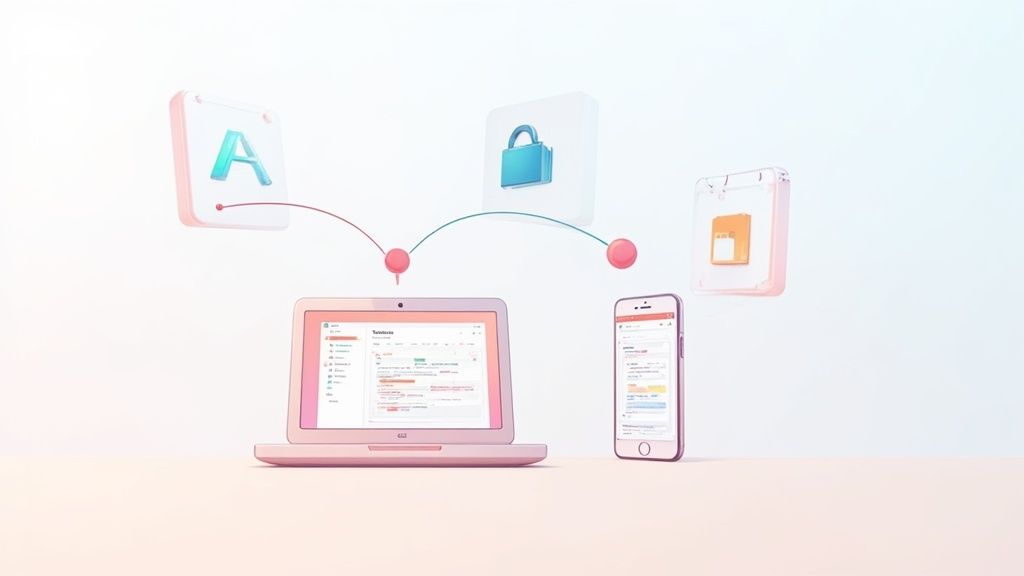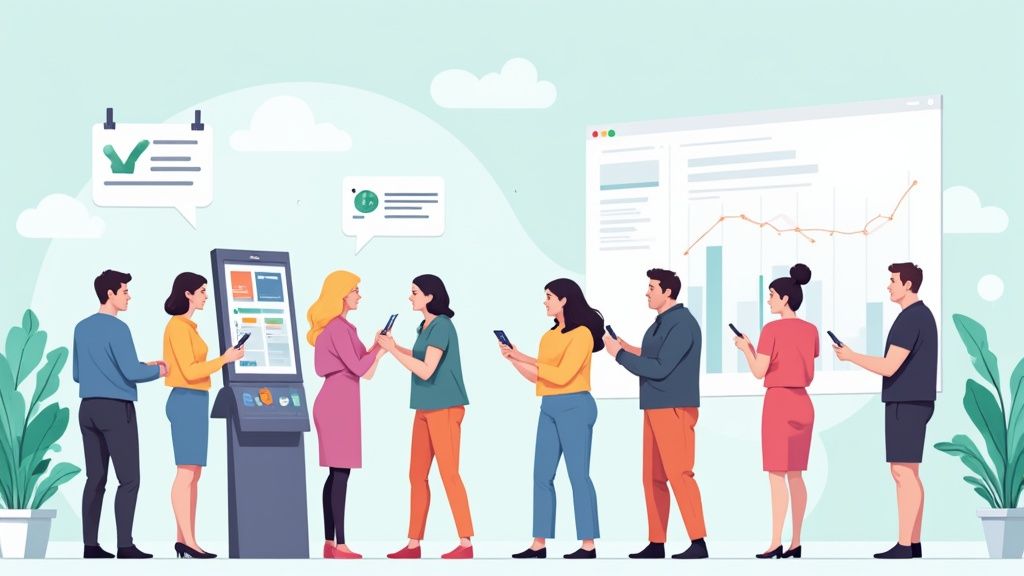If you want to track RSVPs online effectively, you need a system that gives you real-time data on guest responses. It’s all about using a solid online platform to send your invites and instantly see who’s opened them, who’s coming, and who can’t make it. Ditching the old manual methods isn't just a small upgrade - it’s a massive strategic advantage.
Why Modern Event Planning Demands Online RSVP Tracking
Let's be honest, juggling guest lists with paper printouts or clunky spreadsheets just doesn't fly anymore. Moving your RSVP tracking online is a fundamental shift that puts immediate, actionable data right at your fingertips. It’s about turning a simple headcount into a powerful tool for crafting an incredible guest experience.
Gain a Clear Strategic Advantage
Imagine knowing, in an instant, who just opened your invitation, who confirmed, and who might need a gentle nudge. This immediate feedback is gold. It lets you make smarter calls on everything from catering numbers and venue layout to how you're allocating your budget.
This digital approach has truly changed the game, letting organizers manage guest lists way more efficiently. A great real-world example is how Eventbrite’s platform managed to slash event check-in times by about 66%. It’s a perfect illustration of what happens when you have clean, streamlined data.
The real power of online RSVP tracking is moving from reactive planning to a proactive strategy. You stop guessing your numbers and start working with live data, which cuts down on waste and unlocks your event's full potential.
From Manual Labor to Automated Insights
Switching to a digital system drastically cuts down on the tedious admin work. No more manually typing in names and responses. The system does all the heavy lifting, freeing you up to focus on what actually matters - creating an unforgettable event. When you look at comprehensive event planning checklist templates, you'll see that online RSVP tracking is a non-negotiable piece of the puzzle.
Automating this process pays off in a few key ways:
- Real-time Accuracy: Your guest list is always current, reflecting cancellations and new confirmations the second they happen.
- Reduced Human Error: Say goodbye to the typos or missed emails that can completely throw off your headcount.
- Centralized Communication: All your guest information lives in one place, making it a breeze to send targeted reminders or last-minute updates.
Online vs. Traditional RSVP Tracking: A Quick Comparison
To really see the difference, it helps to put the old and new methods side-by-side. The contrast highlights just how much efficiency and insight you gain by going digital.
| Feature | Online RSVP System | Traditional (Mail/Email) Method |
|---|---|---|
| Speed | Instant, real-time updates | Slow, dependent on mail delivery or manual email checks |
| Accuracy | High, with automated data entry | Prone to human error (typos, lost mail, etc.) |
| Data Access | Centralized dashboard, accessible anywhere | Scattered across spreadsheets, emails, and paper lists |
| Guest Experience | Seamless, one-click responses | Clunky, requires manual replies or mailing back a card |
| Planner's Effort | Minimal administrative work | Time-consuming and labor-intensive |
The takeaway is clear. While traditional methods might feel familiar, they simply can't compete with the speed, accuracy, and strategic advantage offered by a modern online system. It's less about just counting heads and more about understanding your audience from the very first touchpoint.
Choosing the Right Online RSVP Platform for Your Event
With what feels like a million RSVP tools on the market, just picking one can be a headache. The trick is to find a platform that actually fits what you’re trying to do, whether that's a small workshop or a massive conference. Your choice directly impacts how easily you can track RSVPs online and get the information you actually need.
The best way to think about it is matching the tool to your event's complexity. A casual get-together? A free, simple option is probably all you need. But for a corporate event, you'll want the heavy hitters - features like custom form fields and the ability to talk to your CRM or email marketing software. Moving to online RSVP tracking has been a huge productivity booster for event organizers everywhere. Letting guests respond online is just easier for everyone, and it kills all that time-consuming manual data entry.
Key Features to Look For
Before you pull the trigger on a platform, run it through a quick checklist. Can you ask specific questions, like for dietary restrictions or which breakout session someone wants to attend? Can it handle the number of attendees you're expecting without crashing?
A few things are non-negotiable:
- Customizable Forms: You need to go beyond a simple "yes" or "no." This is your chance to collect valuable data that helps you create a better, more personal event experience.
- Integration Potential: A tool that connects with your other software (like your email client or calendar) will save you hours of mind-numbing data transfer. Seriously, this is a big one.
- Scalability: Make sure the tool can grow with you. What works for a 50-person mixer might not work for your 500-person annual summit. If you want more details on setting up a process that can scale, check out our guide on how to create an RSVP link.
This decision tree gives you a good visual for figuring out the best path forward based on your event's size and what features you'll actually use.

As you can see, the bigger and more complex your event gets - especially if you need things like automated reminders - the more you'll get out of a premium platform. For smaller events, you can often get by just fine with a simpler, free tool.
Evaluating Based on Your Needs
When it comes down to it, the right choice boils down to three things: your budget, how comfortable you are with tech, and what specific info you need from your guests. Don't get distracted by a laundry list of features you'll never touch.
The goal isn't to find the platform with the most bells and whistles. It's to find the one that makes your job easier and delivers a smooth, professional experience for your attendees from the moment they receive the invitation.
Zero in on a tool that gives you clear, actionable reports and an interface that doesn't make you want to pull your hair out. A well-chosen platform won’t just track your RSVPs; it'll become your command center for understanding and connecting with your audience.
Designing an RSVP Form That Gathers Actionable Insights

A great RSVP form does way more than just count heads - it's your first chance to gather some real intelligence. This is where you can collect the kind of details that turn a good event into a fantastic one for everyone. Forget just getting a number; this is your first step to track RSVPs online in a way that actually shapes your strategy.
The real art is in striking a balance. You want to build a form that's insightful for you but still a breeze for your guests to fill out. You need to ask smart questions without making it feel like a chore, which is the fastest way to get someone to close the tab.
Asking the Right Questions
Going beyond a simple "yes" or "no" is where the magic happens. A few thoughtful additions can give you a goldmine of information.
For a webinar, for instance, asking something like, "What are you most excited to learn?" is invaluable. This little question gives you a direct line into what your audience wants before you even go live.
Here are a few other questions that are almost always worth including:
- Dietary Needs: This is non-negotiable for any catered event. It’s about keeping guests safe and making them feel cared for.
- Session Preferences: If you're running a conference with multiple tracks, this helps you figure out room capacity and where to put your resources. No more guessing games.
- Plus-Ones: Asking for the names of any additional guests keeps your list tight, organized, and professional from the get-go.
Design and Accessibility Really Matter
How your form looks and feels is just as important as the questions you ask. A clunky, hard-to-read form is a major roadblock, especially when most people are RSVPing from their phones. A mobile-first design and clear, simple language are absolute musts if you want a high response rate.
The best RSVP forms feel less like an administrative task and more like the start of the event itself. Keep it clean, intuitive, and focused. Only ask for what you truly need - your guests' time is valuable.
Using custom RSVP websites can seriously level up your ability to collect this kind of detailed attendee data. This is crucial for creating a personalized and well-run event. Gathering specific info on guest preferences doesn't just improve engagement; it can even help you cut down on no-shows.
Connecting RSVPs to Calendars to Boost Attendance

Let's be honest, getting that "Yes" on an invitation feels great, but it's really just the starting line. The real win is getting that person to actually walk through the door. This is where the simple, powerful connection between your RSVP form and your guest's personal calendar changes everything.
Closing this gap is probably the single most effective way we’ve seen to slash no-show rates. When someone says they're coming, you need to make it ridiculously easy for them to remember that commitment. A single button on your confirmation screen can turn a fuzzy intention into a solid plan.
From Confirmation to Calendar
The second a guest hits "Confirm" is your golden moment. They are at their absolute peak of engagement and interest. This is precisely the time to hand them a one-click option to add your event right into their personal calendar.
With our service, we've built the whole process to be seamless. Your guests can instantly save all the event details to their Google, Outlook, or Apple calendar. It's a small action, but it accomplishes a few massive things:
- It plants a persistent reminder directly in their daily schedule.
- It signals a much stronger intention to attend, giving you a more accurate headcount.
- It completely eliminates manual entry errors, so you know they have the right date, time, and location.
An RSVP without a calendar entry is just wishful thinking. An RSVP with a calendar entry is a scheduled commitment, and that drastically increases the chances your guest will show up.
Why This Actually Boosts Attendance
Put yourself in your guest's shoes for a minute. Life is a chaotic mess of appointments and overflowing inboxes. That confirmation email you sent? It can easily get buried and forgotten within hours. A calendar event, on the other hand, is a proactive reminder that works for them, sending notifications and blocking out the time.
This isn't just about making things convenient; it's about psychology. By placing your event directly into their personal planning space, you're embedding it into their life. It solidifies their decision and helps them plan everything else around your event. That’s how a simple RSVP transforms into a reliable part of your attendance forecast. When you track RSVPs online, adding this feature gives you a much clearer, more honest picture of who is truly planning to be there.
Using RSVP Data to Actively Engage Your Attendees
Your job isn’t over once the invites are sent. Actually, this is where the fun begins. Watching the RSVP data roll in gives you the power to build momentum and lock in your event's success long before the doors even open.
Proactive guest management kicks off the second that first "Yes" hits your inbox. Using your platform’s dashboard, you can watch response trends in real-time. This isn't just about getting a headcount; it’s about figuring out who your most enthusiastic attendees are and where you might need to give a little nudge.
Segment and Personalize Your Communication
Once you start to track RSVPs online, you can slice and dice your guest list for much more effective messaging. This is absolutely critical for keeping excitement levels high.
Think about sending a few targeted follow-ups:
- For the Undecided: A friendly, automated reminder about a week before the RSVP deadline can be the gentle push they need to commit.
- For Confirmed Guests: Keep them hooked by sharing speaker previews, a sneak peek of the venue, or a heads-up about networking opportunities.
- For Key Attendees: Spot your VIPs or key stakeholders and shoot them a personal note. A quick message acknowledging their RSVP goes a long way in building a real connection.
This simple strategy transforms your communication from a generic email blast into a meaningful conversation. Once you have a good chunk of RSVPs, you could even use tools like video personalization software to deliver tailored content and reminders that really stand out.
The goal is to make every single attendee feel seen and valued from the moment they say "Yes." This kind of proactive engagement is one of the best ways we know to crush no-show rates and build a loyal community around your events.
Ultimately, these tactics don't just help you manage your list - they directly contribute to a higher turnout. For more ideas on this, our guide on how to increase event attendance is packed with other proven strategies. Handling last-minute changes smoothly and keeping your communication relevant will ensure your guest list stays solid and your attendees stay pumped.
Common Questions About Tracking RSVPs Online
Even with the best tools in your corner, a few questions always pop up when you first start to track RSVPs online. Let's walk through some of the most common ones we hear from event organizers.
How Should I Manage RSVPs For a Free Event?
This is a big one. For free events, getting an accurate headcount is everything - it dictates your budget, your venue choice, and your sanity. The trick is to make saying "yes" completely painless.
Use a dead-simple form and, we can't stress this enough, put an "Add to Calendar" link right on the confirmation page. It's one of the single most effective ways to slash your no-show rate.
A "know before you go" email sent 24-48 hours before the event is our secret weapon. It does more than just remind people; it re-engages them and gives you a perfect excuse to share last-minute details like parking info or the webinar login.
Can My RSVP Tool Connect With Other Software?
Not only can it, it should. Most modern RSVP platforms are built to play nice with other tools you're already using, like Salesforce, Mailchimp, or Google Workspace. This isn't just a "nice-to-have" - it's a massive time-saver.
Setting up these connections means your attendee data syncs automatically across your entire system. No more manual data entry. If you find a tool that doesn't have a direct integration, a connector like Zapier can usually build that bridge for you.
We actually have a whole guide that goes deeper into this. You can check it out here: tracking attendance at events.
How Far In Advance Should I Send Invitations?
Ah, the classic timing question. It really boils down to the type of event you're hosting. There's no single right answer, but here are some rules of thumb that have served us well:
- Big-Ticket Events (Weddings, Conferences): You'll want to send a save-the-date 4-6 months ahead of time. The formal invitation should follow about 6-8 weeks before the event.
- Smaller Gatherings (Webinars, Local Meetups): For these, 3-4 weeks is the sweet spot. It's enough time for people to plan but not so far out that they forget.
Your goal is to find that perfect balance - giving guests enough notice without having your invite get buried in a crowded inbox.
Ready to stop chasing RSVPs and start hosting better events? With Add to Calendar PRO, you can see who's coming, boost your attendance numbers, and keep your guests in the loop from the moment they say "yes." Explore our features and get started today.



